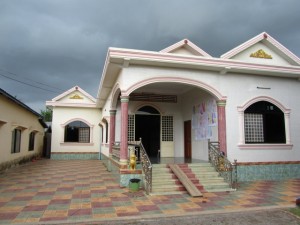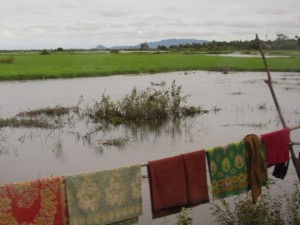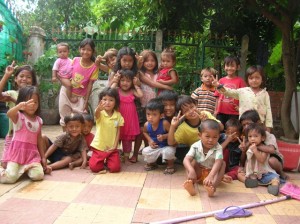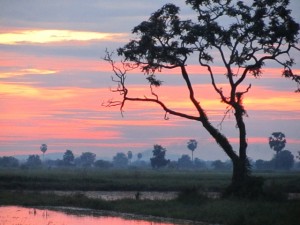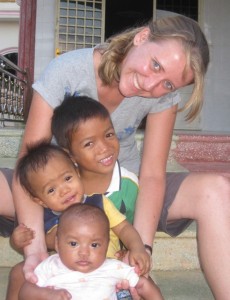We do not need cults huddling on some mountain somewhere to tell us that the Apocalypse is near, that the “end times” are upon us. In some places, the Apocalypse has already happened, is happening — in the Congo, the Sudan, in Syria, in another dozen spots on the map, but one can make the case that Cambodia from 1975 to 1979* offers the most murderous example of apocalyptic violence, societal collapse and ideological madness since the Holocaust.
The Khmer Rouge leader, Pol Pot, said that “what is rotten must be removed,” and when the Khmer Rouge applied that sentence to human beings, it resulted in the obliteration of 25% of the Cambodian population through starvation and executions.**
Camus wrote that “the soul of the murderer is blind”; what else can explain the infinite self-righteousness necessary to drive two million people into the countryside — to forcibly empty the cities because the Khmer Rouge believed that cities by their very nature were counter-revolutionary because they were not inhabited by the peasantry. Education was counter-revolutionary and therefore lawyers, doctors, teachers, professionals of every type, were targeted for terrible treatment and often death. They eliminated money and private property, as if savings and homes and businesses were petty daydreams that could be vanished by a command to awaken. Brian Turner, a poet, ex-marine and combat veteran visited Cambodia in 2010 and wrote this meditation of what he found: Brian Turner on the legacy of 1975-1979
How does a society recover once families are scattered and ruptured by force, once governmental terror becomes the overwhelming presence in an individual’s life, once communities are wiped out, once the rule of law is eliminated, once health care delivery systems are shredded, once a market economy is ground into nothing? Once the Apocalypse passes, what does a country do about beginning again when disease is rampant, orphans are an enormous percentage of the population, and the state of mind of many survivors has become feral or blasted into a kind of shocked detachment?
Cambodia is one of the poorest countries in the world (31% of the population earns less than $1.25 per day***). Ravaged by sex-trafficking and HIV/AIDS, it must also deal with thousands of injuries a year from a myriad of unexploded 30+ year old landmines. Its population bears the psychic scars induced by genocide and war – a bone-deep distrust of authority, law and government, and too often a terrifying lack of empathy, especially as directed toward women. Photo Essay: Missing Arms, Legs, Fathers, Mothers
Such a recovery effort must have lots of money and lots of moving parts to make an impact. One example — to begin to bring Cambodia back you must have a demining operation. Currently there are 40,000 Cambodians who live as amputees due to landmine accidents. Many of the landmines left there cost $3 to manufacture. They cost $1000 per mine to find, remove and destroy. The photo essay documents the appalling cost. Only a large NGO or governmental foreign aid can provide the resources to combat such an enormous problem.
What happened in Cambodia shows the worst that human beings can become and do – the Khmer Rouge disassembled any sense of ordinary human grace and kindness they may have possessed and exchanged those virtues for ruthless, morally insane actions – torture and mass murder. One point five million (1.5) Cambodians were slain in five years by other Cambodians. ***
Place yourself in the state of mind of a Cambodian survivor staggering back to an area he or she once called home and finding it empty of familiar faces and of the structural ties of families and jobs and stores that hold communities together. Some kind of outside aid would be necessary to help that survivor begin again. Cambodia has been devoured by poverty. It cannot rebuild alone. A benign organizing energy for good must serve as an initial center around which communities might begin to coalesce.
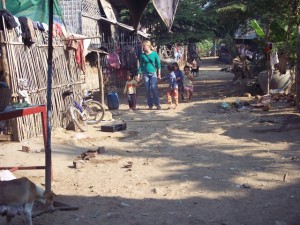
Ultimately, the nexus of efforts to resurrect Cambodia comes down to small teams or individuals making the day-by-day effort to do some good in an area blasted back to day -by-day existential concerns – what will I eat today? Where will I sleep tonight? How can I make a little money today to buy food? How can I protect my children today? To address these existential concerns, there have to be individuals in place who have made a commitment to stay. The right person will build a reserve of trust in the population that he or she has been called to serve. One day and then the next day and then the next and then the next – a little good is added to a little more good. I think this is how most goodness works — as an effort on the part of individuals to make one spot on the map better through their own patient, evolving strength, or through religious belief, or through idealism combined with practical know-how or through some combination of all of these plus empathy and sweat and resilience.
This issue is not theoretical for me. A former student, Laura Altemus, works for an NGO in Cambodia, Jeevit’s House — the first sentence of their mission statement: “Jeevit’s House was founded in March of 2010 in Battambang, Cambodia with the mission to give children with HIV/AIDS a chance at life.”^ Jeevit’s House Video: An Introduction (recall the mentions of Battambang in both Brian Turner’s piece and the Photo Essay)
I do not have an average day. Each one is unique. In short I am a mom, a social worker and a teacher of various subjects. In each of these roles I am learning through field experience and mistakes. In more detail:
Two small brothers have been living with us for approximately 18 months. I see them as my sons. We have had other babies living with us for short times as well. One returned home; one died. Generally, we do not know too far in advance when a child will come or how long he or she will stay. When they come, our schedule shifts to accommodate their needs.
Jeevit’s House primary focus is families affected by HIV/AIDS. A few times a week I visit one slum nearby. I love this street. Fourteen of our 34 children live here. However, there are also other families here who I have known for years that need help as well. I do what I can and pray for grace for them in all the ways I cannot help. I visit the families and bring the kids their weekly sponsorship (formula, milk, juice, school fees, etc.) and check in on how they are doing. The two evenings I am down there are often the highlight of my week.
The bulk of our children live close to us in town. A handful lives out in the province. We attempt to visit them in their homes consistently. The frequency of our visits is dependent upon how far away they are. If it is less than 2 hours, we use our moto (clutch-free motorcycle with a smaller engine, and if it farther away, we rent a taxi.
Twice a week the sponsored children near us can come to our house to play and take uncooked rice home. The neighborhood also joins us just to hang out. We have one of the only playgrounds in town. Whenever our front gate is open, the kids are allowed to come play. This happens almost every evening. We also have a monthly party and serve dinner for our families and the community.
For more than a year now I have been writing foster care paperwork and compiling a training manual for use during foster parent training. This project, while crucial to the next step and future of Jeevit’s House, quickly gets pushed aside in the craziness of daily life.
I sometimes translate for lectures or meetings. I teach another foreigner Khmer two mornings a week. In my spare work time I have translated some children’s stories with the help of one of my friends. It’s been a few months since I’ve even looked at any the stories though. A few days a week we have children’s programs in different slums and villages. I only help in 2 of the 5 locations, but I am in the process of assembling the curriculum, activities and teaching aids we use.
We regularly have outreach teams or guests come through our base for anywhere from a few days to three months. Long-term teams jump into our regular schedule. With short-term teams we often help facilitate a VBS (Vacation Bible School) or occasionally medical clinics. Emergencies are dealt with as they arise.
Laura’s description of her life in Battambang is a compilation of a list of tasks – this must be done and then this, oh, unless this occurs, and then we have to switch up and do this instead. How else can a way of life be rebuilt? I know Laura’s name, but every day in Cambodia many people whose names we will never know decide to add their portion of energy and actions to sustaining and encouraging life.
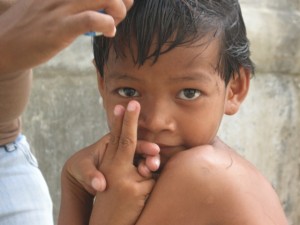
As I’ve matured I’ve tried to think of the time between Thanksgiving and Christmas as those weeks when it is most proper to note the realms of goodness that exist in my personal life and in the larger world. Cambodia suffered the apocalypse, but evil also calls forth nobility. Jeevit’s House has become one of those luminous spots on the map where the powers of goodness do patient work, as clear-eyed as possible, day to day, taking nothing for granted.
**www.historyplace.com
***www.cia.gov
